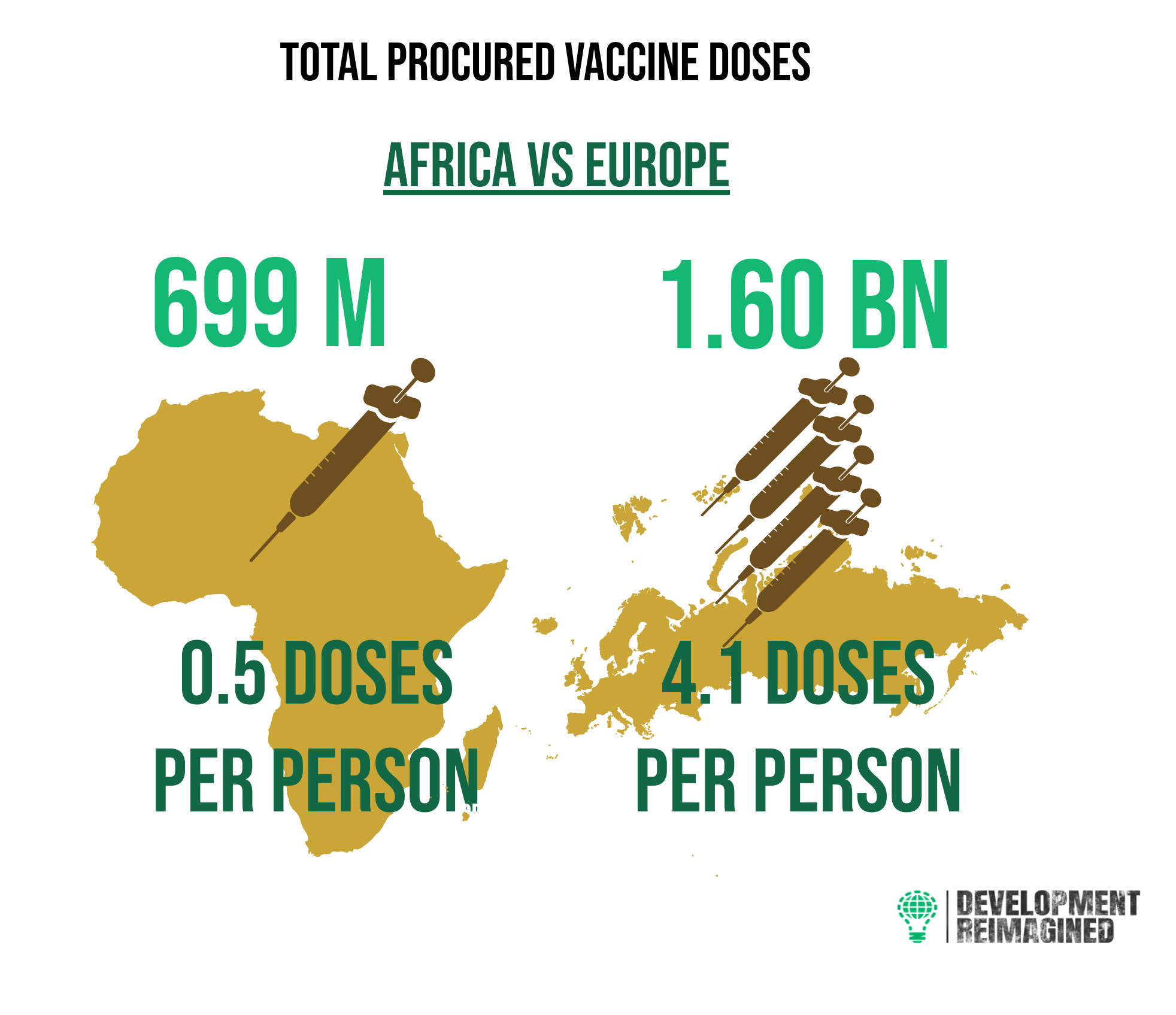Updated Every Month
As COVID-19 social distancing interventions continue to be relaxed in many countries in favour of vaccine-led strategies, while new variants of COVID-19 continue to emerge, the way forward for global COVID-19 management seems very unclear. Our infographics have continually demonstrated the continued efforts of African governments to vaccinate their populations. However, vaccine supply for African countries has been very slow. Is it realistic for African countries to focus on vaccine-led management strategies? This question is what this month’s infographic tries to answer.
Since the beginning of the pandemic, there have been 12.7 billion vaccines acquired globally. However, African countries account for only 5% of these doses, whilst the majority have been acquired by Asia, Europe and North America. In terms of population, Asian countries as a group have acquired 2 vaccines per person, North America 3 vaccines per person, and Europe 4.1 vaccines per person. Hoarding in some regions is clearly happening. In sharp contrast, African countries have acquired just 0.5 vaccines per person. With such few doses, even with younger populations than some other regions, a vaccine-led COVID-19 management strategy is highly risky. So why so few vaccinations?
The low doses are not for trying! Vaccine campaigns have been launched and are working – 67% of vaccine supplies on the continent have been used already. However, in vaccine expenditure, African countries represent only 5% of the global total spent on vaccine procurement. Considering many African countries are low-income countries it is reasonable to assume expenditure would be less than continents with a higher number of middle and high-income countries. However, African countries also represent a small percentage of global vaccine donations. For example, only three African countries – Kenya, Egypt and Tunisia – are represented in the top 20 countries that received vaccination donations – and all are middle-income.
Meanwhile, African countries are dependent on others for the procurement of a very wide variety of vaccines. In contrast, Asian countries overwhelming rely on Asian-produced vaccines such as Sinovac and Sinopharm – which together make up more than 50% of Asia’s vaccine supply. This means that of the 134 billion USD spent on vaccine procurement in Asia, over 50% was spent within the Asian continent, with concomitant benefits in terms of revenues and jobs.
This is similarly true for North America and Europe. These regions have benefitted from their own vaccine spending on North American and European produced vaccines such as Pfizer and Moderna. Simultaneously they have also gained from the popularity of these vaccines around the world – for example, Pfizer and AstraZeneca account for over 50% of Oceania’s vaccine supply.
Another significant marker for Africa is vaccine delivery. Supply of vaccines across African countries has been sporadic, with the majority of doses received towards the end of 2021. For other regions, the highest levels of vaccine delivery were met much earlier and sustained throughout the year. For example, over 50% of Europe’s vaccine doses were received in summer 2021. In North America, highest supply in March 2021 dwarfed Africa’s highest total by almost 100 million doses.
For African countries, these inequities in vaccine availability create a dangerous context, especially with global public health measures waning and new COVID-19 waves expected to emerge. While stringent lockdowns have their own challenges, our analysis suggests that African countries cannot rely on vaccines only – they will need to continue to have some types of social distancing measures in place for the long-term.
Whatever the decision, a key lesson is also in relation to local manufacturing. Not only is there significant economic incentive now for vaccine production on the continent, it will avoid the effects of hoarding, while securing future access to new innovations, such as mRNA vaccines, that is efficient and sustainable and tackles future health inequities.
And finally, as we write this, the IMF and World Bank Spring meetings are getting started. As institutions expected to be assisting countries in meeting global public goods, our analysis provides clear evidence that significant reform is needed in such institutions, now.
This rich and informative data behind this analysis is available below. Have a read, check out the graphics and numbers below, and do let us know what you conclude and what you’d like us to find out next time!
 To find out how Development Reimagined can support you, your organisation or Government to respond to COVID-19 in a sustainable way please email the team at clients@developmentreimagined.com.
To find out how Development Reimagined can support you, your organisation or Government to respond to COVID-19 in a sustainable way please email the team at clients@developmentreimagined.com.
Special thanks go to Rosie Flowers-Wanjie, Osaru Omosigho, David Tinashe Nyagweta and Jing Cai for their work on the graphics and collecting/analysing the underlying data and this accompanying article.
The data was collated primarily from Africa CDC, as well as other sources including: government websites and media reports, the IMF policy tracker; Worldometer and the New York Times Vaccine Tracker. Our methodology is entirely in-house, based on analysis of vaccine, testing, spending, social distancing, income categories and other trends.
If you spot any gaps or have any enquiries, please send your feedback to us at team@developmentreimagined.com, we will aim to respond asap.
April 2022


